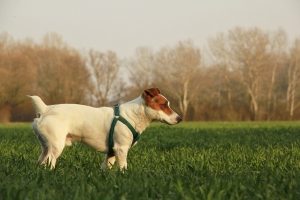Ask Crystal: One Step at a Time
 Dear Crystal,
Dear Crystal,
My 6-month pup constantly sits or lays down on a walk. Treats can get him going a little. What can I do to work on this?
Sincerely,
Stubborn Pup
Dear Stubborn,
This can be a very embarrassing problem in the moment, but it is actually a pretty common problem for a lot of dogs at various points in their lives. Some dogs are more prone to the behavior than others. I think the reason for the behavior in some dogs is surprising to people. Many people perceive their dog is being stubborn or lazy and that is often not the motivation.
I have a 6-month-old pup that frequently stops and lays down when he perceives that we are leaving the park or just going a different direction than he would like to go. My technique for his stopping has been working pretty well for me. I tend to walk him on a long line, so he has some freedom, when we are in a spot where that is permitted. When he lays down, I stop and give the leash slack. You do not want the dog to feel tension or pulling on the leash as that often causes them to pull back harder. I give him a second to lay there and then I cheerfully say, “Let’s go!” and when he gets up to move, I start moving and he comes with me. The important technique here is that I am not pulling on him and just giving him a moment before I ask him to move.
Why Dogs Lay Down
Often, the reason a dog is laying down on a walk is some sort of discomfort or aversive if it isn’t like my dog who simply doesn’t wanna. This seems to be the story of his puppy life right now. There are some different things in the environment and on the dog that we can examine to try to narrow down the cause of the behavior.
It goes without saying, but we should never pull a dog or puppy if they don’t want to walk. Occasionally, I have given a dog that a little light tug and a “let’s go” and that will get them going but we never want to drag a dog around. Besides the fact that we could seriously injure their neck, we are causing an even more negative association with something that the dog is already struggling with. Respect what your dog is telling you and try to investigate potential causes of the behavior.
First, be sure your dog is not in any physical pain. He is a young dog so he may be pretty healthy, but it is always good to take him in to the vet and just make sure all his limbs are in good shape and not painful. Especially, anytime a behavior is new to an animal, a medical cause may be to blame.
Watch your dog when he does walk. Does he tend to walk more in the grass, on the sidewalk, in shady spots than he does on other places? Depending on the time of year, the ground can be painful to walk on. If it is too cold in the winter or too hot in the summer, those can be reasons why a dog might not want to walk.
It could be that there was something that scared him once—like he stepped on a painful burr, got stung by a bee, heard a scary siren or the traffic could be very loud at that point. It’s hard to know what happened in the past but if you can remember anything that may have scared him. Take a look around at the traffic or anything like a large item like a trash can that the dog is avoiding. Does he not want to walk at all or if you try to go in another direction would he come with you? If he is willing to walk in a different direction, that may give you a clue as to what is scaring him. One of my dogs was afraid of storm drains. I didn’t realize it at first. She would stop walking and lay down at certain points and once even pulled out of her collar and just sat in the road. I finally realized what it was, and we were able to do some counter conditioning and desensitization and get her past it. She also was afraid to walk on bridges, so we had to work on that as well. There are a lot of things that can be scary for a dog especially a dog at that age.
Fear Periods
Puppies go through fear periods which can occur anytime between 6-14 months. Your once confident pup can suddenly be afraid of things which to us may seem silly. My new pup alarm barked at a stump until he walked all the way up to it and could check it out. It’s important that we are not forcing them to interact with scary things. Let them decide if they want to move away or towards the object. Praise and treat them for looking at you for guidance or for looking at the scary object. They are in control of how close they get. Just reward any looking at the object, moving towards it or checking in with you and do every time you encounter the object.
It is always a good idea to study up on canine body language to make sure you can understand the puppy’s subtler signs of discomfort. This will be extremely helpful in narrowing down what might be scaring him and helpful in many other situations besides helping you better understand your dog and bond with them. A dog’s body weight will shift in different ways depending on how he is feeling. If he is nervous about something he may stretch himself forward with his back legs stretching back. Or he may shift his weight backwards if he is frightened by something. Other body language could be crouched posture, looking away, head down, ears back, whale eyes, freezing and shaking. These all indicate fear of something in the environment.
Once we know what it is the puppy is reacting to, we can then work on a training protocol of counter conditioning and desensitization towards the trigger. You may want to consult a Certified Professional Dog Trainer for help with this type of training. Find on here: Certified Dog Trainer and Behavior Consultant Directory – CCPDT
Check the Gear
 Is your puppy completely comfortable in all his walking gear? If his collar is too tight and pinching him when he walks or pulls that could cause pain. Ill-fitting harnesses can often rub dogs raw under their legs and in other places so it could be that a different harness will help. Have you spent time acclimating him to all his gear including his leash?
Is your puppy completely comfortable in all his walking gear? If his collar is too tight and pinching him when he walks or pulls that could cause pain. Ill-fitting harnesses can often rub dogs raw under their legs and in other places so it could be that a different harness will help. Have you spent time acclimating him to all his gear including his leash?
Have you been practicing his leash walking at home first? I start with all dogs at home inside, reinforcing for being in the correct position by my side and then reinforcing each step that he takes with me. I usually feed my dog his meal this way every night. We actually started without the leash on so you may be able to start there and just make walking with you more fun for him. If you reinforce eye contact while walking, you will have an engaged puppy that is checking in with you for guidance.
If you are having the same problem at home, you may want to work on some games which will make you more interesting to the puppy. Bring out his favorite toy and play if he seems bored. Or maybe run off and say, “Catch me!” while leaving a trail of treats. Once you have played these games enough at home, you can try them on walks as well to make yourself more interesting. Always carry really good treats on walks and reinforce any walking by your side. Many people don’t bring treats on walks or don’t bring good enough treats to compete with the environment. Having really great treats helps motivate the dog to move but we don’t want to use it to lure the dog past scary things if possible because they can force them past their comfort threshold.
If he is not too big and these tips aren’t working, you can always pick him up and carry him until he will walk again. It’s not really teaching him anything but is better than pulling him. Keep working to try to figure out what is going on. Most dogs love walks so usually if they aren’t enjoying it, something is scary to them or uncomfortable in some way. Good luck and happy training!
Until next time,
Crystal
Submit your own pet behavior question for Crystal here:







